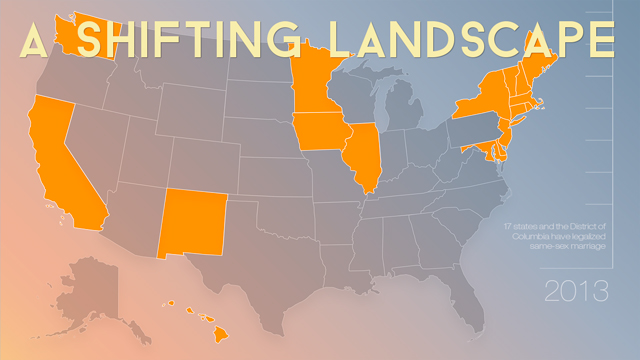A Shifting Landscape: A Decade of Change in American Attitudes about Same-sex Marriage and LGBT Issues, released just this morning, uncovers a wealth of new data on U.S. public opinion toward a range of LGBT issues. Below are a few highlights; for the full report, click here!

- In the decade since Massachusetts became the first state to legalize same-sex marriage, Americans’ support for allowing gay and lesbian people to legally wed has jumped 21 percentage points, from 32 percent in 2003 to 53 percent in 2013, transforming the American religious landscape.
- While most religious groups opposed same-sex marriage in 2003, today there are religious groups on both sides of the issue. Nearly three-quarters of religiously unaffiliated Americans (73 percent) favor allowing gay and lesbian couples to legally marry, in addition to majorities of Jewish Americans (83 percent), white mainline Protestants (62 percent), white Catholics (58 percent) and Hispanic Catholics (56 percent). Hispanic Protestants are divided; 46 percent favor allowing gay and lesbian couples to legally marry and 49 percent oppose. By contrast, nearly 6- in-10 (59 percent) black Protestants and nearly 7-in-10 (69 percent) white evangelical Protestants oppose same-sex marriage.
- A strong majority (58 percent) of Americans, including 7-in-10 (70 percent) Millennials (ages 18 to 33), agree that religious groups are alienating young people by being too judgmental about gay and lesbian issues. Notably, nearly one-third of Millennials who left their childhood religion to become unaffiliated say negative teachings about or negative treatment of gay or lesbian people were either a somewhat (17 percent) or very (14 percent) important factor in their decision to leave.
- Today, nearly 7-in-10 (69 percent) Millennials favor same-sex marriage, compared to 37 percent of Americans who are part of the Silent Generation (ages 68 and older).
Americans who have a close friend or family member who is gay or lesbian are 27 points more likely than those who do not to favor allowing gay and lesbian couples to legally marry (63 percent vs. 36 percent). This “friends and family” effect is present across all major demographic, religious and political groups.
Be sure to check out the full report, including topline and research methodology, over on our research page.




